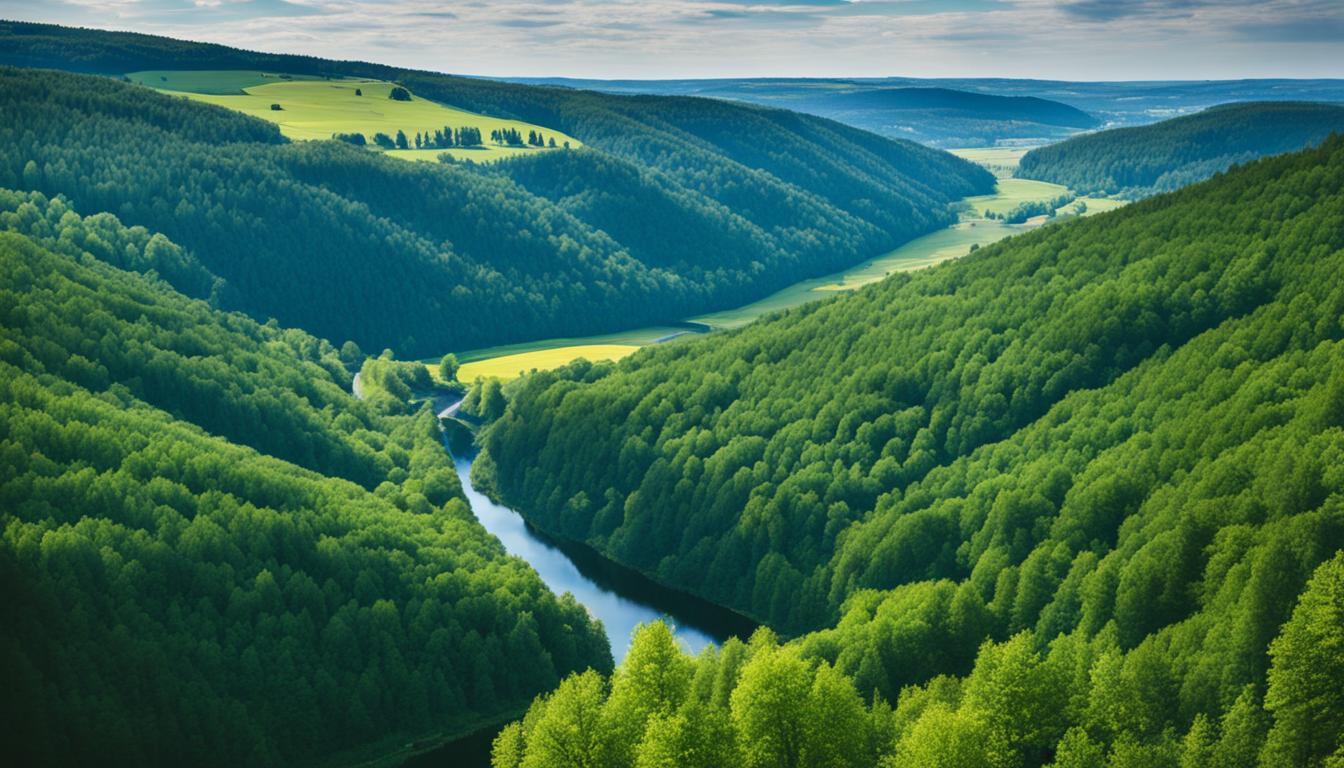Portugal Biodiversity: Animal and Plant Species and What Is Under Threat
Portugal, officially the Portuguese Republic, is a country located in southwestern Europe on the Iberian Peninsula. It is bordered by the Atlantic Ocean to the west and south and by Spain to the north and east. Portugal is known for its rich biodiversity, with a diverse natural heritage and unique ecosystems. It is home to approximately 3,600 species of plants, 69 terrestrial mammal taxa, 313 bird species, and numerous amphibian and reptile species. However, many of these species are under threat, and the country faces challenges in conserving its biodiversity.
Key Takeaways:
- Portugal possesses a diverse range of plant and animal species
- Conservation efforts are essential to safeguard the country’s biodiversity
- Endangered species face significant threats in Portugal
- Public awareness and education are crucial for promoting biodiversity conservation
- The country’s rich natural heritage requires collaborative efforts for protection
Overview of Portugal’s Biodiversity
Portugal’s geographical location and geophysical conditions contribute to its diverse natural heritage and rich biodiversity. The country is known for its stunning landscapes and unique ecosystems that support a wide range of flora and fauna. From the Azores and Madeira Archipelagos to the mainland, Portugal offers a haven for numerous species.
Portugal is home to approximately 3,600 species of plants, including endemic species found nowhere else in the world. These plants thrive in a variety of habitats, ranging from coastal dunes to mountain ranges, showcasing the country’s remarkable plant diversity. The flora in Portugal covers a wide range of species, providing a vibrant tapestry of colors and scents.
When it comes to wildlife, Portugal doesn’t disappoint. The country boasts an impressive array of terrestrial mammals, birds, amphibians, and reptiles. Animal lovers will enjoy the chance to spot Iberian lynx, wild boars, wolves, and several unique bird species. With diverse ecosystems and favorable nesting grounds, Portugal serves as a migration stopover for numerous birds, making it a birdwatcher’s paradise.
Among the notable biodiversity hotspots in Portugal are the Azores and Madeira archipelagos. These islands, situated in the Macaronesian region, harbor a wealth of unique and endemic species. The isolation of these islands over centuries has led to the evolution of distinct flora and fauna, making them ecologically significant in the conservation of Portugal’s biodiversity.
| Flora | Fauna | Biodiversity Hotspots |
|---|---|---|
| Approximately 3,600 species of plants, including endemics | A diverse range of terrestrial mammals, birds, amphibians, and reptiles | The Azores and Madeira archipelagos |
With its diverse natural heritage and abundance of wildlife, Portugal presents a captivating destination for nature enthusiasts and conservationists alike. The country’s commitment to preserving its biodiversity and protecting its unique ecosystems is crucial for the future of Portugal’s wildlife and sustaining its remarkable natural beauty.
Threats to Portugal’s Biodiversity
Despite its diverse natural heritage, Portugal faces various threats to its biodiversity. Habitat loss and degradation, climate change, invasive alien species, and unsustainable human activities pose significant challenges to the country’s ecosystems. Endangered species, particularly freshwater fish and steppe birds, are strongly threatened by these factors. Additionally, the lack of knowledge about natural values and insufficient conservation efforts contribute to the decline of biodiversity in Portugal.
The protection of biodiversity in Portugal is crucial for the preservation of ecosystems and the survival of endangered species. Habitat loss and degradation result from activities such as deforestation, urbanization, and intensive agriculture. These activities destroy vital habitats and disrupt the delicate balance of ecosystems, leading to the decline of numerous plant and animal species. Climate change exacerbates these threats by altering environmental conditions, affecting the distribution and behavior of species.
Invasive alien species also pose a significant threat to Portugal’s biodiversity. These non-native species can outcompete and displace native species, disrupting native ecosystems. Invasive plants, animals, and pathogens can cause severe ecological and economic damage. Efforts are being made to monitor and control these invasive species, but more proactive measures are needed to prevent their introduction and spread.
Unsustainable human activities, such as overexploitation of natural resources, pollution, and improper waste management, further contribute to the degradation of ecosystems in Portugal. Overfishing and illegal hunting have resulted in the decline of several fish and mammal species. Pollution from industrial and agricultural sources contaminates water bodies, affecting freshwater ecosystems and the species that depend on them. Improper waste disposal leads to habitat destruction and threatens both terrestrial and marine biodiversity.
Furthermore, the lack of knowledge about the value of biodiversity and the importance of conservation efforts hinders effective protection. Education and awareness programs are vital in promoting a sense of responsibility and encouraging sustainable practices among the general public and policymakers. It is essential to emphasize the interconnectedness of ecosystems and the critical role biodiversity plays in maintaining ecosystem services and human well-being.

Conservation Efforts in Portugal
Portugal has made significant strides in protecting its biodiversity through various conservation measures. The country has implemented legislation, such as the National Biodiversity and Nature Conservation Strategy, aimed at identifying and characterizing invasive species while developing effective methodologies for control and eradication.
Control programs targeting invasive species have been successfully implemented in protected areas, including the Natural Park of Sintra-Cascais and the Natural Reserve of Paul do Boquilobo. These initiatives aim to safeguard native flora and fauna by effectively managing and minimizing the impact of invasive species on local ecosystems.

The Institute for Nature Conservation and Biodiversity, actively involved in the management of protected areas, plays a vital role in the successful implementation of conservation strategies and initiatives in Portugal. The institute’s expertise and efforts contribute to the preservation and sustainable management of the country’s diverse natural habitats.
| Conservation Measures in Portugal | Protected Areas |
|---|---|
| Legislation for identifying and controlling invasive species | Natural Park of Sintra-Cascais |
| Control programs for eradicating invasive species | Natural Reserve of Paul do Boquilobo |
| Institute for Nature Conservation and Biodiversity | – |
Conservation Measures in Portugal
- Legislation for identifying and controlling invasive species
- Control programs for eradicating invasive species
- Institute for Nature Conservation and Biodiversity
Forest Cover and Biodiversity
Approximately 41.3% of Portugal’s land area is covered by forests, contributing to the country’s rich biodiversity. Forests serve as vital habitats for diverse plant and animal species, playing a crucial role in supporting and preserving Portugal’s natural heritage.
Within Portugal’s forested areas, 1.5% is classified as primary forest, representing untouched and primeval ecosystems. These primary forests are of exceptional ecological importance, harboring unique and sensitive species that rely on undisturbed habitats to thrive.
However, Portugal has witnessed changes in forest cover over time, with reforestation rates declining in recent years. This decline in forested areas can have detrimental effects on biodiversity, as it reduces the availability of suitable habitats and disrupts the interconnected ecosystems that support a wide range of plant and animal life.
To safeguard Portugal’s biodiversity, it is crucial to protect and conserve the remaining primary forests and manage forest resources sustainably. This involves implementing responsible forestry practices that prioritize biodiversity conservation while meeting societal needs.
By adopting sustainable forest management strategies, Portugal can strike a balance between economic development and environmental stewardship, ensuring the long-term survival of its unique and valuable ecosystems.

Protected Areas and Biodiversity Conservation
Portugal is committed to the conservation of its precious biodiversity through the designation of protected areas. These areas, including biosphere reserves, Ramsar sites (important wetlands), and World Heritage sites, play a crucial role in safeguarding Portugal’s unique flora and fauna. Covering approximately 4.4% of the country’s land, these protected areas are categorized under International Union for Conservation of Nature (IUCN) classifications I-V, signifying their high ecological value.
Protected areas in Portugal serve as biodiversity hotspots, preserving endemic and threatened species and important habitats. The conservation efforts within these areas aim to maintain the delicate balance between human activities and the preservation of natural ecosystems.

A breathtaking view of one of Portugal’s protected areas, showcasing its diverse landscapes and rich biodiversity.
Cooperation across various sectors is instrumental in ensuring the effective management and protection of these protected areas. Ongoing efforts focus on enhancing awareness and understanding of the value of biodiversity, fostering sustainable practices, and promoting responsible tourism within these conservation areas.
| Benefits of Protected Areas in Portugal | Conservation Efforts and Measures |
|---|---|
|
|
Threats to Freshwater and Marine Biodiversity
Freshwater and marine environments in Portugal are also facing significant threats to their biodiversity. Human activities, including pollution and habitat destruction, have resulted in a decline in freshwater species populations. Additionally, the loss of wetlands and alterations to river courses have further contributed to the degradation of these ecosystems.
Conservation efforts are urgently needed to protect and restore freshwater habitats in Portugal. By implementing measures to reduce pollution, preserve natural water flows, and enhance habitat restoration, it is possible to reverse the damage and ensure the survival of freshwater species. Collaborative initiatives involving local communities, government agencies, and conservation organizations are key to the success of these efforts.
Similarly, marine biodiversity in Portugal is at risk due to various factors. Pollution from industrial activities, agricultural runoff, and marine litter has detrimental effects on marine ecosystems. Overfishing and destructive fishing practices also deplete fish populations and disrupt the balance of marine habitats.
To ensure the preservation of marine biodiversity, it is crucial to implement effective conservation measures. This includes the monitoring and control of invasive marine species, the establishment of marine protected areas, and the promotion of sustainable fishing practices. By protecting essential habitats, regulating human activities, and promoting ecosystem-based management, it is possible to safeguard the marine biodiversity of Portugal.

Table: Threats to Freshwater and Marine Biodiversity in Portugal
| Threats | Freshwater Biodiversity | Marine Biodiversity |
|---|---|---|
| Pollution | Decline in water quality affecting species populations and ecosystems | Damage to marine ecosystems and disruption of food chains |
| Habitat Destruction | Loss of wetlands and alterations to river courses | Destruction of coral reefs and other marine habitats |
| Overfishing | Depletion of fish populations and disruption of aquatic ecosystems | Unbalanced marine ecosystems and decline of commercially important fish stocks |
| Invasive Species | Competition with native species and alteration of freshwater habitats | Disruption of marine ecosystems and loss of biodiversity |
Efforts to mitigate these threats require the collaboration of government bodies, researchers, conservation organizations, and local communities. By addressing the root causes and implementing sustainable practices, Portugal can protect and preserve its valuable freshwater and marine biodiversity for future generations.
Public Awareness and Education for Biodiversity Conservation
Public awareness plays a vital role in promoting biodiversity conservation in Portugal. It is crucial to educate the general public and policymakers about the value of biodiversity and the threats it faces. Increased knowledge and understanding of the importance of natural values are essential in driving conservation efforts.
Educational programs, awareness campaigns, and the dissemination of information are effective tools in fostering a sense of responsibility towards biodiversity conservation. These initiatives not only provide the public with valuable knowledge but also encourage sustainable practices that contribute to the preservation of Portugal’s unique ecosystems.
By raising public awareness and promoting biodiversity education, Portugal can empower individuals and communities to actively participate in conservation initiatives. This collective effort plays a significant role in ensuring the long-term protection and sustainability of the country’s biodiversity.

The Importance of Biodiversity Education
Biodiversity education is crucial in creating a future generation that values and understands the significance of ecological diversity. By educating children and young adults about the importance of biodiversity, Portugal can foster a generation that actively engages in conservation efforts and adopts sustainable practices.
Through educational programs in schools, nature centers, and community organizations, Portugal can inspire future environmental stewards who appreciate the interconnectedness of all living organisms and recognize their role in maintaining a balanced ecosystem.
By incorporating biodiversity education into curricula and providing students with hands-on experiences in nature, Portugal can nurture a sense of curiosity and wonder about the natural world. This not only enriches their educational journey but also equips them with the knowledge and skills needed to become responsible and engaged citizens.
Awareness Campaigns and Information Dissemination
Awareness campaigns and information dissemination are powerful tools in reaching a wider audience and instigating positive change. By leveraging various communication channels, Portugal can effectively raise awareness about biodiversity conservation and mobilize individuals to take action.
Efforts such as social media campaigns, public exhibitions, and environmental events can capture public attention and spark conversations about the importance of biodiversity. By presenting compelling stories, facts, and examples, these initiatives can inspire individuals to make conscious choices that support conservation efforts.
Furthermore, the dissemination of information through accessible and engaging platforms, such as websites, brochures, and online resources, ensures that individuals have the opportunity to learn about Portugal’s unique biodiversity. Providing easily understandable and scientifically accurate information enables individuals to make informed decisions and actively contribute to biodiversity conservation.
The Role of Policymakers and Stakeholders
Policymakers and stakeholders have a crucial role to play in promoting public awareness and education for biodiversity conservation. By integrating conservation principles into policies and collaborating with educational institutions and organizations, Portugal can create an enabling environment for long-term sustainability.
Collaborative efforts between government agencies, non-governmental organizations, and academic institutions can facilitate the development and implementation of effective educational programs and awareness campaigns. Through participation in workshops, conferences, and consultations, policymakers can gain valuable insights and perspectives from experts and the public, leading to informed decision-making.
By prioritizing biodiversity education and public awareness, Portugal can ensure that these efforts are woven into the fabric of society. This holistic approach fosters a culture of conservation that permeates all sectors and empowers individuals to make sustainable choices in their daily lives.
Conclusion
The protection and preservation of Portugal’s biodiversity are vital for the future of the country’s unique natural heritage. With approximately 3,600 species of plants and a wide array of terrestrial mammals, birds, amphibians, and reptiles, Portugal boasts a diverse ecosystem.
To ensure the longevity of this biodiversity, it is crucial to implement effective conservation strategies. The establishment of protected areas, such as biosphere reserves and wetlands, plays a significant role in safeguarding endangered species and their habitats.
However, conservation efforts should not be limited to protected areas alone. Public awareness and education are paramount in promoting sustainable practices and fostering a sense of responsibility towards biodiversity conservation. By raising awareness about the value of Portugal’s biodiversity and the threats it faces, we can inspire individuals and policymakers to take an active role in its protection.
Continued collaboration between stakeholders, including government agencies, conservation organizations, and local communities, is essential for the long-term success of biodiversity conservation in Portugal. By joining forces and implementing comprehensive conservation measures, we can ensure the preservation of Portugal’s rich and unique natural heritage for future generations.
FAQ
What is Portugal’s biodiversity like?
Portugal is known for its rich biodiversity, with a diverse natural heritage and unique ecosystems. It is home to approximately 3,600 species of plants, 69 terrestrial mammal taxa, 313 bird species, and numerous amphibian and reptile species.
What are the threats to Portugal’s biodiversity?
Portugal faces various threats to its biodiversity, including habitat loss and degradation, climate change, invasive alien species, and unsustainable human activities. Endangered species, such as freshwater fish and steppe birds, are strongly threatened by these factors.
What conservation efforts are in place to protect Portugal’s biodiversity?
Portugal has implemented several conservation measures, including legislation such as the National Biodiversity and Nature Conservation Strategy. Control programs for invasive species have been implemented in protected areas, and the Institute for Nature Conservation and Biodiversity plays a crucial role in conservation management.
How does forest cover impact biodiversity in Portugal?
Approximately 41.3% of Portugal’s land area is forested, with 1.5% classified as primary forest. Forests play a vital role in supporting biodiversity by providing habitats for diverse plant and animal species. Continued protection and sustainable management of forest resources are crucial for promoting biodiversity conservation.
What are the protected areas in Portugal and their role in biodiversity conservation?
Portugal has designated protected areas including biosphere reserves, wetlands of international importance, and World Heritage sites. Approximately 4.4% of Portugal’s land is protected under IUCN categories I-V, representing areas of high ecological value. These areas play a crucial role in conserving endemic and threatened species and preserving important habitats.
What are the threats to freshwater and marine biodiversity in Portugal?
Human activities, such as pollution and habitat destruction, have led to a decline in freshwater species populations. Wetland loss and alterations to river courses further contribute to the decline of these ecosystems. Marine biodiversity is at risk due to pollution, overfishing, and habitat destruction.
How can public awareness and education contribute to biodiversity conservation in Portugal?
Public awareness and education play a crucial role in promoting biodiversity conservation in Portugal. Increasing knowledge and understanding of natural values among the general public and policymakers is essential. Initiatives such as educational programs, awareness campaigns, and information dissemination can foster a sense of responsibility and promote sustainable practices.
Why is the protection of Portugal’s biodiversity important?
Portugal’s biodiversity is diverse and unique, but it faces significant threats. Conservation efforts, including the establishment of protected areas and the implementation of conservation strategies, are crucial for safeguarding Portugal’s biodiversity. Protecting and preserving biodiversity is important for the ecological balance and the well-being of both wildlife and humans.








